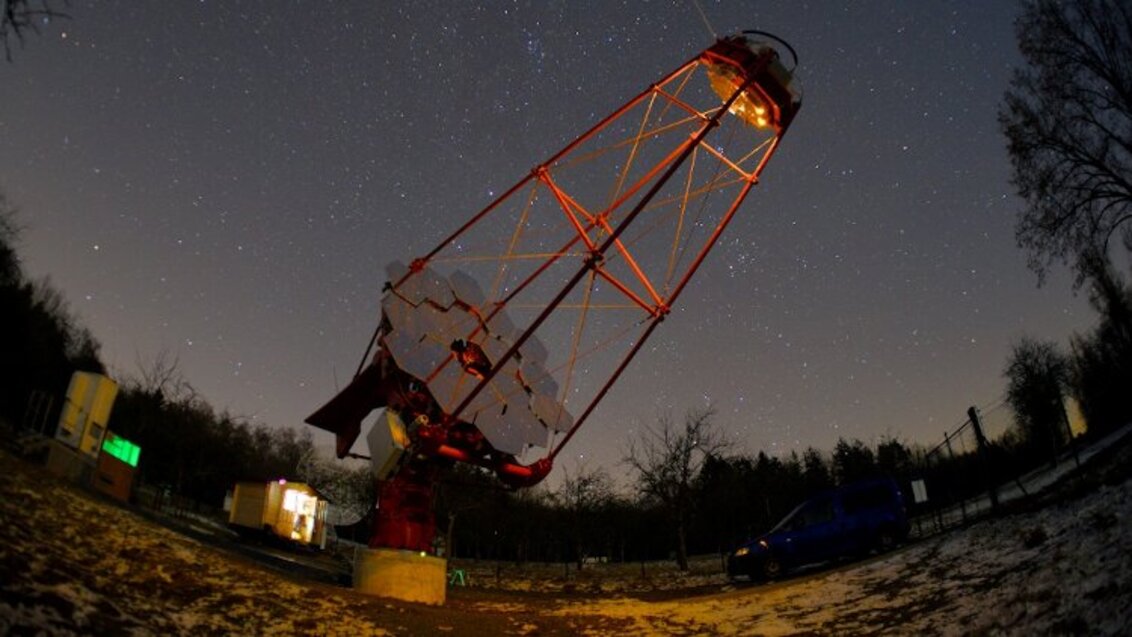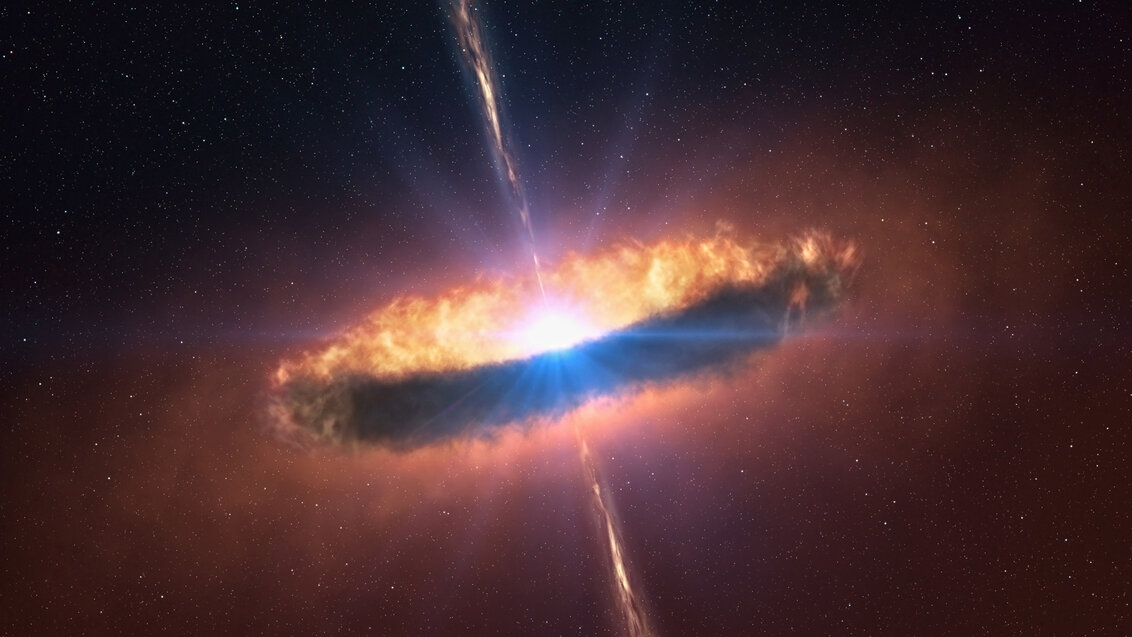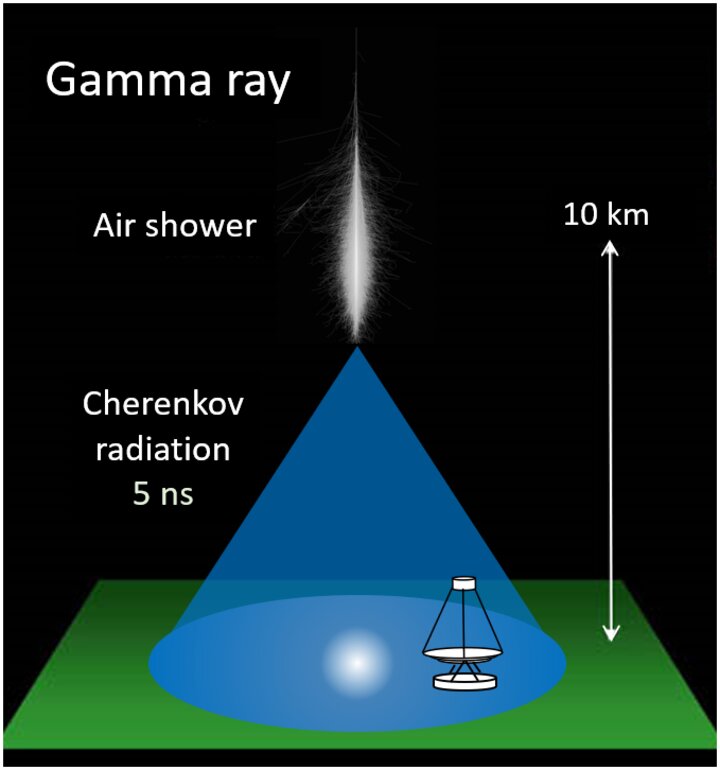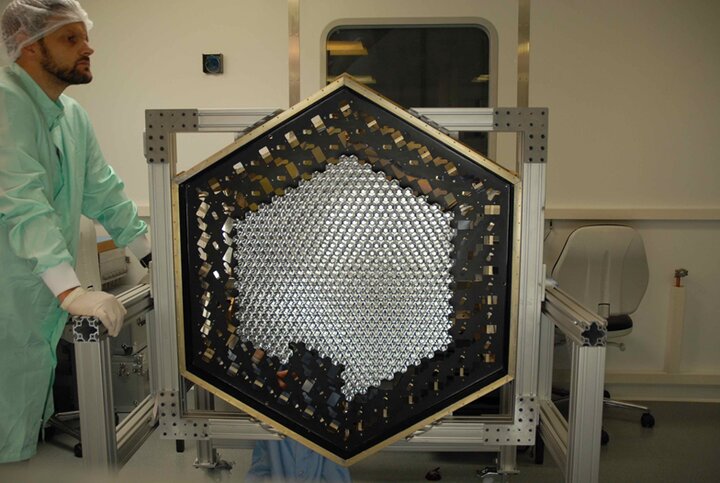The Cherenkov Telescope Array is one of the largest astronomical projects in the world, which aims to erect ground-based observatories for investigating high-energy gamma radiation in space. This great endeavour has engaged more than 1,000 scientists from across the world, including a sizeable team from Poland, which is also made up of researchers from the AGH UST. Together with specialists from the JU, they were responsible for developing a telescope camera that has proven better, in many ways, from devices proposed by other international partners. The prototype telescope, with the said camera mounted, located in the Ondřejov Observatory, has registered its first flares caused by gamma rays from outer space towards the end of February 2022.
High-energy astronomy
Gamma rays (marked with the Greek letter γ) is the most energetic form of electromagnetic radiation. One of its terrestrial sources are atomic bomb explosions that emit highly ionised photon beams that are harmful to the health and life of humans. This type of radiation is also responsible for the brightest phenomena in the sky, namely the gamma-ray bursts (GRBs). Initially, it was thought that their cosmic source must be somewhere in our galaxy, since the observed energies were exceptionally high – nearly a million times greater than when an atomic bomb explodes. Soon, however, the hypothesis of Bohdan Paczyński, a prominent Polish astrophysicist, was confirmed, and we now know that the sources of these bursts are definitely extragalactic. Today, it’s common knowledge that gamma rays reach Earth from distances amounting to billions of light years, and, similarly to nuclear explosions, they originate from grand catastrophes: super- and hypernova explosions and collisions of black holes and neutron stars.
We might say, therefore, that the universe has its own giant particle accelerators that generate radiation with energies that are beyond our grasp here on Earth. How is it then that humans don’t experience negative effects of this radiation? The answer is simple: We’re protected by the Earth’s atmosphere that disperses the harmful gamma rays. However, this shield is a problem for the observers who are eager to explore the secrets of high-energy space. This is why the first gamma-ray detectors were placed in the orbit, but due to some major setbacks, this solution wasn’t satisfactory enough – the most energetic photons remained outside the grasp of our astronomers. Then, it dawned on the brilliant scientists to use the atmosphere itself as a detector. It turned out that it was possible thanks to the Cherenkov radiation that is generated as a result of the interaction of gamma rays with the Earth’s gas layer. It appears as flashes of blue light, which can be observed using appropriate optical telescopes.
Cherenkov Telescope Array
This idea constitutes the foundation of one of the largest astronomical projects in the world, that is, the Cherenkov Telescope Array (CTA), named after the discoverer of the aforementioned radiation. The project implies the construction of ground-based astronomical observatories that will be able to register very short (lasting several billionths of a second) bursts in the Earth’s atmosphere, caused by gamma rays. Because Cherenkov radiation resides in the visible electromagnetic spectrum, it can be registered with the use of optical telescopes. Ultimately, the CTA plans to build two large observatories – in the southern and northern hemispheres – equipped with several dozen optical telescopes of varying proportions (with mirror diameters of 4, 12, and 23 metres). Their synchronisation, by means of a stereoscopic technique that is based on observing a specific phenomenon from an array of points, will allow scientists to pinpoint a place in space from which any registered photon came. Using multiple telescopes will enhance the sensitivity of the instrument, allowing researchers to reduce the noise, which was a major issue in the case of single detectors placed on the orbit.
This array of telescopes will be one of the largest observation networks in history. The CTA project is indeed a combination of efforts of numerous research groups from around the world that deal with high-energy astronomy. Already more than 1,000 researchers from almost 30 countries are involved in activities that aim to build the observatories. These numbers include 70 scientists and engineers from Poland, coming from 9 different research centres. Their input constitutes a significant element of the project – their chief task is to build a prototype of a small telescope, as well as high-class composite mirrors and cutting-edge digital cameras, which might be mounted on all the devices. Participation in the CTA is a wonderful opportunity for Polish researchers to take part in the development of innovative technologies and in the possible discoveries in the field of astrophysics. According to the scientists, observation of high-energy gamma rays can take us a step closer to understanding the secrets of dark energy and matter – two great mysteries of modern science.
Silicon eyes on the lookout for gamma rays
This grand endeavour also features engineers from the Institute of Electronics at the Faculty of Computer Science, Electronics, and Telecommunications, who, together with specialists from the JU Astronomical Observatory and a Swiss research team from the University of Geneva, have built a digital camera with ultrafast electronics. Their device for registering gamma radiation also uses innovative silicon photomultipliers that were manufactured specifically for this project by a Japanese company Hamamatsu. It turns out that the technological solution proposed here is, in a variety of ways, superior to the ones developed by other international teams. The camera based on semiconductor photomultipliers can, for instance, operate even during moonful nights, as the silicon detectors are not blinded by the reflected sunlight – contrary to the currently used vacuum photomultipliers. Moreover, it is quite small and is based on a fully digital and programmable concept called DigiCam. An important role in the construction of this camera was played by our ingenious AGH UST electronic engineers under the supervision of Paweł Rajda, DSc.
‘The first significant achievement of the scientists from the AGH UST and the JU was to apply analogue-digital converters to the early stage of signal processing. This facilitated the creation of a path for signal processing that operates in the digital domain, rather than – as it was until now – the analogue one. The structure was based on programmable digital systems that make it easy to modify the architecture of the device, which was a huge advantage as far as this particular project was concerned. This was an idea that came from German scientists with whom we’d cooperated closely at the beginning. At the same time, our Western colleagues were advocating the use of vacuum photomultipliers, whereas we and the team from Switzerland have decided to make use of the newly introduced silicon photomultipliers, so this is where we parted ways with the Germans. Silicon photomultipliers, despite certain flaws, have quite a few significant advantages, which seemed essential to us – they required a lower supply voltage (about 70 V rather than 1000–2000 V), they were more deterministic in terms of photon detection, and they allowed us to reduce the size and weight of the digital camera three times. To achieve this increased level of equipment integration, we built in, on a massive scale, serial digital interfaces to the structure of the camera. They are able to transfer data at a speed of 8 gigabytes per second. This idea and its implementation is our second most important, and fully proprietary, achievement. The entire camera is indeed a highly specialised computational system that processes input data from the detectors at a speed of more than 4 terabytes per second!', says Dr Paweł Rajda.
Thanks to this modern camera, which was mounted on a small prototype telescope named SST-1M, in 2017, during trials on the premises of the Institute of Nuclear Physics of the Polish Academy of Sciences in Krakow, the first gamma photon was observed in Krakow. This was a crowning conclusion of the effort and a confirmation of concept. Currently, the SST-1M project involves more than a dozen research institutes from 4 countries (Poland, Switzerland, the Czech Republic, and Ukraine). Their work is coordinated by researchers from the University of Geneva. The prototype telescope is currently located in the Ondřejov Observatory, where, on February 23, 2022, during subsequent tests, it registered new Cherenkov radiation bursts caused by high-energy gamma-ray photons. Soon, its twin device will join it. The second telescope will probably receive its camera later in April, and then the two will begin operating in stereoscopic mode. This is a huge success, and one that our AGH UST engineers are a major part of, who enrich the project with their knowledge in the field of new technologies.
SST-1M Telescope collecting data at the Ondřejov Observatory. Source: obserwatorium-cta.pl




 Pre-election meeting with a candidate for the position of rector
Pre-election meeting with a candidate for the position of rector  Agreement on cooperation with OPAL-RT
Agreement on cooperation with OPAL-RT  Krakow DIANA Accelerator consortium members with an agreement
Krakow DIANA Accelerator consortium members with an agreement  Meeting with the Consul General of Germany
Meeting with the Consul General of Germany  More Academic Sports Championships finals with medals for our students
More Academic Sports Championships finals with medals for our students  Launch of AGH University Student Construction Centre
Launch of AGH University Student Construction Centre  Bronze for our swimmers at Academic Championships
Bronze for our swimmers at Academic Championships  Smart mountains. AGH University scholar develops an intelligent mountain rescue aid system
Smart mountains. AGH University scholar develops an intelligent mountain rescue aid system